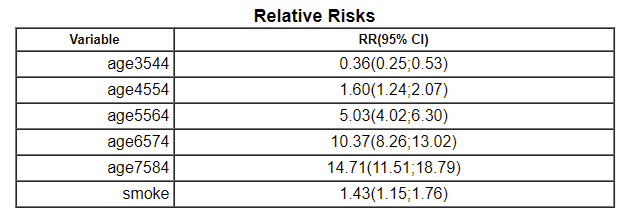If you run an additive Poisson regression model, then rate $\lambda_{ti} = a + \beta_{ti}$ will be the rate among the age group. However, you have a multiplicative model so the rate will be $\lambda_{ti} = \exp(a + \beta_{ti})$. The rates predicted via additive vs. multiplicative can be very different. My experience has been that the additive gives better approximation of rates than multiplicative, which is mostly used to determine relative risk (RR) or excess relative risk (ERR). Multiplicative Poisson regression is typically the default model used by most software. Some packages don't run additive models for Poisson.
Below is an example dataset called the British Smoking Doctors dataset. There's a smoking and non-smoking group, and $\lambda_0$ is the age specific rate (cases/person-years) for non-smokers multiplied by 1,000, and $\lambda_1$ is the age-specific rate among smokers multiplied by 1000. (thus, person-years is divided by 1,000 before input).

Below are the coefficients from a multiplicative model when a constant term was not used, in order to get a rate estimate for every age group -- i.e., there's no $a$ like in your model:

Below are the coefficients from an additive model:

Notice how the estimated coefficients from an additive model sit right on top of the rates listed in the table. Not true for the multiplicative model. This is why I stated the additive model returns estimates closer to the original rates.
The multiplicative model is used to estimate the relative risk of smoking, which is 1.43=exp(0.355). So age-specific rates increase by 1.43 for smoking. For additive, the rates increase by addition of 0.59.
Even when you exponentiate coefficients from the multiplicative model, the estimated baseline rates are not as close at those represented by additive coefficients:

As far as the appropriate model, if you run a geometric mixture model, where purely additive is $\rho=1$, and purely multiplicative is $\rho=0$

you'll find that $\rho=0.55$ results in the lowest deviance goodness-of-fit. This is shown in the plot below:

References:
R. Doll, A.B. Hill. Mortality of British doctors in relation to smoking: Observations on coronary thrombosis. Nat'l. Cancer Inst. Monogr. 19:205--268, 1966.
C.R. Muirhead, S.C. Darby. Modelling the relative and absolute risks of radiation-induced cancers. J. Royal Stat. Soc. A. 150:83--118, 1987.






